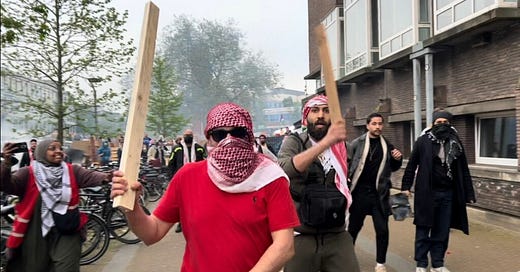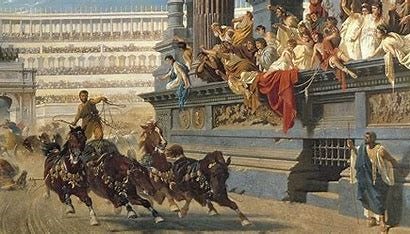SOCCER HOOLIGANISM: YOUNG MEN SEEKING POWER
Amsterdam, a city known for its liberal sensibilities, the Anne Frank house, and its bravery hiding Jews during the nazi occupation, broke out in antisemitic violence last week. After a soccer match between Dutch and Israeli teams, hordes of young people on scooters and on foot, chased after Israeli fans, punching and kicking them. Prior to the game, pro-Palestinian demonstrators were banned from congregating outside the stadium, while a large group of Israeli’s chanted anti-Arab slogans. Amsterdam mayor, Femke Halsema reported, “there is talk of people going on a Jew hunt.” Dutch Minister of Justice and Security, said, “That is so shocking and so despicable that I still cannot fathom it.” Europeans roundly condemned the violence.
An Associated Press report put the Amsterdam violence in perspective. “The attacks shattered Amsterdam’s long-cherished view of itself as a beacon of tolerance and haven for persecuted religions…” While the violence in Amsterdam was antisemitic, it is also the latest example of thuggish behavior by soccer fans.
Here’s a sample.
May, 1968 – Nearly 300 people were killed and 500 injured after Argentina beat Brazil in an Olympic qualifying match.
March, 1975 – Members of a Mexican soccer club kicked and beat an opposing member to death for making an obscene gesture.
May, 1985 – A tragic riot at a match between English and Italian teams in Brussels, led to thirty-eight people being crushed to death.
February, 1995 - A 19-year old was stabbed to death at a game in Italy. As a result, for the first time in fifty years, all soccer games were cancelled in Italy.
April, 1999 -Ninety-five people, most from Liverpool, were killed trying to push their way into a soccer match.
2005 - Even local politics plays a part. Lazio fans, who are conservatives, chanted fascist slogans while Livorno fans who are leftists, waved red flags with the communist symbols.
April, 1989 - An incident in Italy illustrates how athletics can intertwine with nationalism, politics, geographic identity and hate-filled tribalism. Even Shakespear was involved. At a match between Naples and Verona, Naples fans unfurled a banner insulting one of Verona’s cherished symbols, the location of Shakespear’s Romeo and Juliet. The banner went viral.
JULIET — YOU ARE A TRAMP
Even literary characters who do not exist, can be objects of ridicule.
"Being a soccer fan in Italy is for many, a way of expressing allegiance to one's hometown," wrote Alessandro Rizzo, for the Associated Press. "And in a land that was once a collection of city-states engaged in constant fighting; emotions can run high.”
American scholar, Bill Buford, lived and travelled with soccer thugs as they made their way around Europe. He concluded that their brutish behavior had nothing to do with economic or social oppression. He called them “raving, hysterically nationalistic, social deviants.” They are “a bored, decadent (generation,) so deadened that it uses violence to wake itself up.”
“We’ll get more next time,” said one of the British hooligans in the 1985 riot. “We ran after them to kill them,” said another.
A SUBSTACK SIDEBAR
++++++++++++++++++++++++++++++++++++++++
Violence on the field of play has been going on for millennia. In 532, CE a riot in the Hippodrome in Constantinople, almost brought down Justinian, one of the greatest Emperors in Roman History. The “Nika Riot,” possibly the deadliest arena violence in human history, lead to the deaths of approximately 30,000 people. Ongoing rivalry between Blues and Greens was a continuation of a factional rivalry dating back centuries to the old Roman Empire. Blues and Greens were chariot racers who thrilled the tens of thousands of spectators who came out to the Hippodrome to passionately cheer for their sides. Most people in Constantinople identified with one side or another. But it went far beyond a mere sporting event; the two sides differed on politics, religion, economics and social issues.
The Nika riot in Constantinople - 532 CE
Even the Emperor identified with one side or the other depending upon the
political climate. The Blues represented the aristocracy and orthodoxy while the Greens generally came from the lower classes and were more inclined to support heresies. Sometimes there were riots in the stadium; sometimes the riots spread to the city where factions invaded each other's territories.
In a moment of solidarity in 532, the two factions united in the Hippodrome to convince Emperor Justinian to give mercy to two condemned criminals, one Blue and one Green. The emperor, who was a Blue, disagreed with the spectators who became agitate, then angry, then enraged. Overcome by what can be described as a mass psychosis, thousands of crazed spectators, spilled out of the Hippodrome and into the city, where they burned down most of the public buildings, including the jewel of the city, The Hagia Sophia. The riot went on for several days, essentially destroying one of the great cities of antiquity.
The riot made no sense, but riots often have no logical purpose, or direction, or leaders; they take on a life of their own.
++++++++++++++++++++++++++++++
In looking for an explanation for the arena violence, it’s worth looking at what does not cause it.
It is caused by heavy drinking. Alcohol only fans the flames.
It’s not, as Rom Harre’ of Oxford wrote of the 1985 riot, “…a way of gaining a place in society by fighting – the same way medieval knights gained honor by jousting.” Knights were highly skilled, individual gladiators who fought under controlled conditions with clear rules. Soccer hooliganism is chaotic group violence.
It is not, as some sociologist/apologists contend, “rooted in the tensions of modern society.” Modern society doesn’t have a monopoly on problems. The past was much worse. Insecurity, child abuse, fear, disease, helplessness, hopelessness, disorder, and injustice were the norm.
What then causes mob violence?
Crowds have a magical appeal to the weak and disaffected. They confirm an individual’s identity. Surrounded by dozens, or thousand or hundreds of thousands of like-minded people with similar goals (winning the game, hating the opposition) the individual knows – at least for the moment – who he is and who they are. Hatred is galvanizing. It’s the glue that coalesces thousands of weak and wavering individuals into a potent and aggressive mass. The more they hate, the better they feel. Alone, the individual is nothing, together he has the power of 10,000 men. As lone entities, these young men are failed and powerless, but the crowd transforms them, to use Erich Fromm’s phrase, from impotence to omnipotence. Outside the arena, most live prosaic lives, but in the arena, statuses melt away, personal problems disappear, as they become equal to everyone around them, unstopped and unforgiving force. “It is for this blessed moment,” wrote Elias Canetti, in his brilliant book, Crowds and Power, “when no-one is greater or better than another, that people become a crowd.”
Judy, a girl at the legendary Woodstock music festival, could have been speaking for all who immerse themselves in the warm embrace of the mob, when she said, “I just had a feeling that, wow, there are so many of us. We really had power…I felt here’s the answer to anyone who calls us deviates.”
Don’t believe the apologists who tell you that society, or poverty, or unemployment or discrimination are responsible for the “lads” churlish behavior. Every society has its angry young men waiting for the opportunity to lash back at a world that has not given them their due. In the bosom of the crowd, they commit atrocities they never would have had the courage to do as individuals. In the bosom and camaraderie of the mob, they gain equality. Some join racist hate groups. Some become mercenaries, salivating at the thought of sacking another city. Some, like the ignorant and self-important university students who chant genocidal messages, find that the empowering equality of the mob to be profoundly exhilarating. And some go to soccer games.






